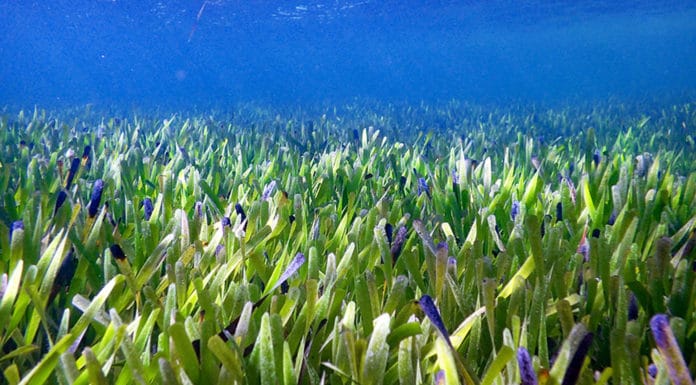Scientists discovered the largest known plant on Earth
And it's 4,500 years old.
Shark Bay, Western Australia, is a World Heritage Area dominated by temperate seagrass meadows. Recently, scientists from the University of Western Australia and Flinders University have discovered the most giant planet at Shark Bay.
They discovered an ancient and incredibly resilient seagrass, Posidonia australis, that stretches 180km and is estimated to be at least 4,500 years old.
Evolutionary biologist Dr. Elizabeth Sinclair from UWA’s School of Biological Sciences and the UWA Oceans Institute said, “The project began when scientists wanted to understand how genetically diverse the seagrass meadows in Shark Bay were and which plants should be collected for the seagrass restoration.”
“We often get asked how many different plants are growing in seagrass meadows, and this time we used genetic tools to answer it.”
UWA student researcher Jane Edgeloe, a lead author of the study, said, “the team sampled seagrass shoots from across Shark Bay’s variable environments and generated a ‘fingerprint’ using 18,000 genetic markers.”
“The answer blew us away – there was just one! Just one plant has expanded over 180km in Shark Bay, making it the largest known plant on Earth.”
“The existing 200km2 of ribbon weed meadows have expanded from a single, colonizing seedling.”
“What makes this seagrass plant unique from other large seagrass clones, other than its enormous size, is that it has twice as many chromosomes as its oceanic relatives, meaning it is a polyploid.”
“Whole-genome duplication through polyploidy – doubling the number of chromosomes – occurs when diploid ‘parent’ plants hybridize. The new seedling contains 100 percent of the genome from each parent, rather than sharing the usual 50 percent.”
“Polyploid plants often reside in places with extreme environmental conditions, are often sterile, but can continue to grow if left undisturbed, and this giant seagrass has done just that.”
“Even without successful flowering and seed production, it appears to be resilient, experiencing a wide range of temperatures and salinities plus extreme high light conditions, which would typically be highly stressful for most plants.”
Journal Reference:
- Jane M. Edgeloe, Anita A. Severn-Ellis et al. Extensive polyploid clonality was a successful strategy for seagrass to expand into a newly submerged environment. DOI: 10.1098/rspb.2022.0538

Jessica Thomson
Newsweek
© iStock / Getty Images Plus
In a paper released on Tuesday, scientists have announced that they have discovered the largest-known clone on the planet—a giant seagrass plant.
While it's not quite a massive Dolly the Sheep, the clone is actually a single, widespread polyploid clone of the seagrass Posidonia australis, spanning at least 180km (a little over 110 miles) in Shark Bay, Western Australia. According to co-author Dr. Elizabeth Sinclair, a senior research fellow at the School of Biological Sciences & Oceans Institute, University of Western Australia, the previous record-holder was only around 50km across.
In 1996, Dolly the sheep became the first mammal to be successfully cloned.
While animal clones, like Dolly, are grown from adult cells and are genetically identical to the single parent, this giant seagrass plant grew from a single seed. According to Sinclair, the difference is that the seed contained a full set of chromosomes from both the pollen donor and the maternal plant, making it polyploid: it has twice as many chromosomes (40 chromosomes) as its diploid oceanic relatives (20 chromosomes).
"Whole genome duplication through polyploidy occurs when diploid 'parent' plants hybridize. The new seedling contains 100 percent of the genome from both parents, rather than sharing the usual 50 percent, and therefore has lots of genetic diversity. This seagrass plant continued growing, expanding through vegetative or clonal growth, where the new shoots are genetically identical to the original seedling," Sinclair told Newsweek.
The near pristine conditions of Shark Bay, which is an International Union for Conservation of Nature (IUCN) World Heritage Area, meant that this huge seagrass has remained relatively undisturbed its entire life, including since European settlement. The plant has been able to continue growing so large through vegetative growth, the way a strawberry plant would in your back garden, extending its runners outwards and growing another little clone of itself where it touches back down on the ground.
This giant seagrass clone has gotten so big that it has begun to make its own environment more stressful to grow in.
As Sinclair told Newsweek: "Seagrass meadows modify their local environment. The leaves 'filter' particles (sediment or soil particles, bacteria and so on) out of the water. The particles then accumulate on the seafloor, keeping the waters shallow and crystal clear. Seagrass also reduces water flow—which is great for protecting coastlines—but in a bay, such as Shark Bay, reduced water flow, combined with low rainfall and freshwater input, the high evaporation rates in summer mean the water gets much saltier. The seagrass now grows in high salinity waters (up to about 1.5 time normal seawater), experiences a high annual temperature range (shallow water heats up and cools down quicker than in the deeper ocean), all of which combined with high light conditions makes the environment more stressful."
Despite these self-inflicted setbacks, Posidonia australis will hopefully be okay in its newly stressful home—polyploid plants (and animals) have more copies for genes, which can be a very effective way of increasing genetic diversity, and this one is very diverse: 90 percent of the 18,000 genetic markers were variable, according to Dr. Sinclair. This may give the polyploid an advantage over normal diploid plants, and enable it to cope with a wider range of environments or different environments from diploids.

No comments:
Post a Comment